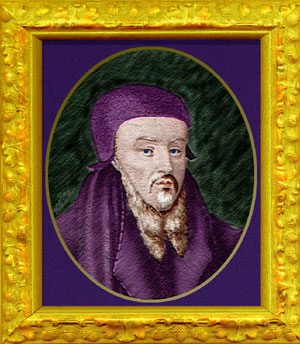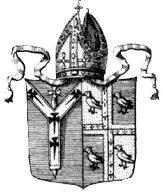

Strype the early biographer of Archbishop Grindal places his birth in the hamlet of Hensingham now part of Whitehaven. However, more recent research would seem to disprove this. We know he was born in St. Bees parish, which included the surrounding villages of Hensingham and Whitehaven, which at that time was still just a small cluster of houses. Strype may have confused another Robert Grindal buried at Hensingham in 1587 with Edmund's older brother of the same name. Edmund himself mentioned being born at a small holding built by his father and brother. Strype thought this was either Overend farm or Chapel House at Hensingham. A paper by John Todd published by CWAAS puts the Grindal family farm at 19-20 Finkle Street, also known as Cross Hill, in St. Bees. Grindal therefore doesn't have a direct connection with Whitehaven although it is local enough to be included here.
William Grindal appeared in St. Bees and built his farm between 1500 and Edmund's birth that is thought to be between 1517 and 1520. It is said that as a literary young man his life was saved when a stray arrow hit him in the chest but lodged in a book in his breast pocket. Whilst his brother stayed at home to run the family farm Edmund went to Cambridge in 1536 to study. Studying at Magdalene and Christ's Colleges and then at Pembroke Hall, he graduated in 1541, with an M.A.
After being one of Edward IV's chaplains his strong Puritan views prevented him becoming bishop and he wisely left the country during the reign of the bigoted catholic Mary Tudor. After visiting Strasbourg he travelled to Frankfurt and tried to settle arguments between Coxians and Knoxians and also collected information that formed the basis of the Book of Martyrs.
When Elizabeth I ascended to the throne he returned to England and was consecrated Bishop of London. Following the earlier dissolution of the monasteries the tenure of the farm at St. Bees was unstable but in 1560 Edmund intervened and helped his brother buy the lease from Thomas Challoner. From this we find the land was about 30 acres leased for 8 shillings per year.
In 1561 his Cathedral, St. Pauls, was ravaged by fire after the spire was hit by lightning and was destroyed along with the roof and much of the building. This was seen as sign from God by both sides of the religious divide but with the help of money from Elizabeth I and £1200 from Grindal himself it was repaired by 1564. The spire wasn't replaced as this was the second time it had been hit by lightning.
In 1570 Grindal became Archbishop of York which had few fellow puritans. This was a period of religious political struggle and it seems that he may have been removed from London to reduce his puritan influence there, however, Elizabeth then became inclined to this view herself and when the Archbishop of Canterbury position became available Grindal was awarded it in January 1575/6.

Unfortunately his brother Robert died in 1568 along with Robert's wife and son leaving the farm to Ann his daughter who was only 18. Within a year she had married William Dacre who got involved with his family in an ill fated uprising which led to their lands being forfeit to the crown. Edmund once again stepped in to buy back the farm for his niece. It is possible that wall paintings which appear to be from the 16th century found at Cross Hill may be of a Griffin and Bull, emblems used by the Dacre family.
He had not been Archbishop long when he disagreed with Elizabeth and failed to back down, making the point that God's work over-ruled a mortal, even a great monarch. Against Elizabeth's wishes Grindal refused to suppress meetings of the clergy called 'prophesyings' where they debated the meanings of the scriptures; a method Edmund had used in York. Because he was popular her anger was tempered by political judgement and he kept his life. For this he was denied his jurisdiction but still maintained his spiritual post. His jurisdiction was restored in 1582 but he had gone blind and his health was failing and he died in April 1583.
Before his death he endowed a free grammar school at St. Bees and drew up detailed instructions for its running. He left money to the poor not just in his home town but also Canterbury, Lambeth and Croydon where he was buried. Freehold land that had passed from Challoner back to the crown was purchased by Grindal's executors for St. Bees school, which gave it back to the tenants with fixed rate leases.
© WAWL 2006